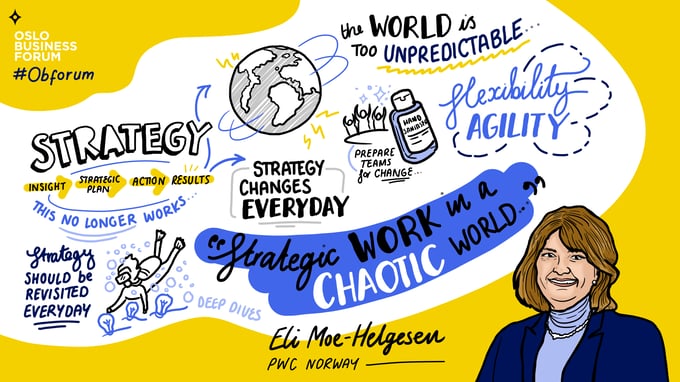Eli Moe-Helgesen is a partner and national leader of Audits and Related Services for PwC Norway. She is an expert in corporate governance and offers organizations insight into leading in a volatile and complex world.
At Oslo Business Forum, Eli discussed how to do strategic work in a chaotic world and offered leaders a new approach to developing strategy in the face of complexity.
The Traditional Strategy Approach
As business leaders, we often find ourselves engaged in strategic planning once a year. We gather the executive team, the board of directors, and possibly even strategic advisors. We sequester ourselves for several days to construct a roadmap meant to guide each step we’ll take in the year ahead.
It’s a traditional approach that all leaders have learned. It begins with a strategy analysis, leads to gathering insights, culminates in a documented plan, then prompts action, and hopefully achieves results.
"The world isn’t standard. It isn’t linear".
“But this simply doesn’t work anymore,” said Eli. “Because the world isn’t standard, it isn’t linear.”
Consider your experience navigating strategy during a worldwide pandemic, during social and political unrest, and during economic crisis. How many of the plans you made were cast aside because they would no longer work in those new circumstances? We cannot work with strategy using the traditional approach because something will always happen to render our original plans useless.
.jpg?width=2000&name=MaxEmanuelson_OsloBusinessForum_MAX09329%20(1).jpg)
A More Dynamic Approach
So, what are the good companies doing?
Eli believes that leaders today must design a strategy process that is continuous, agile, and reflects what’s going on in the present. A more dynamic process may be a winding path that looks more like this:
Establish a strategic vision, conduct a risk assessment, do a strategic deep dive, and take action. From that action, you will learn something that requires another strategic deep dive and collection of new information. You may repeat this process several times and perhaps even reverse decisions. It will never end, but you will be making progress.
This more dynamic approach allows companies to react in change. “It is a fantastic signal to the organization about how to initiate innovation,” said Eli.
The most successful companies today work with strategy as a continuous process, making it something they do every day and every week. They search for new information all the time and use that information to pivot their plans. They build this approach into their organizational DNA.
- Strategy is an ongoing process.
- It is not something you do once a year.
- You must train your ability to change.
She left leaders at Oslo Business Forum with humble but sage advice: “Don’t listen to people who think difficult questions can be solved by three-point bullet lists,” she said. “Build these capabilities in your organizations.”
Key Points
- The old approach to strategy development is no longer effective.
In today’s complex environment, strategy is an ongoing process. - Strategy development must be continuous, agile, and reflect what’s going on in the present.
- You must train your ability to change and build this capability in people across your organization.
Questions to Consider
- How has your approach to developing strategy evolved in the last several years?
- Have you allowed your annual plan to be stale and unusable? Or do you continually revisit, reevaluate, and refine your strategy?
- How engaged is your board of directors in continually refining your strategy? How can you invite ongoing discussion?

Want to be a part of the OBF community? Join Oslo Business Forum 2023: Thriving in Chaos now!.png?width=680&name=CTA_2023%20(2).png)